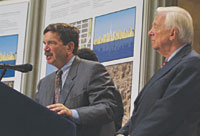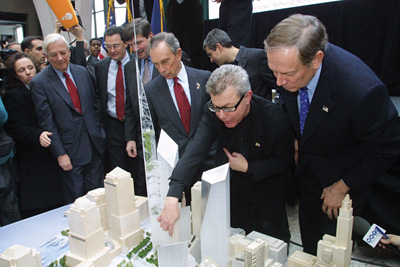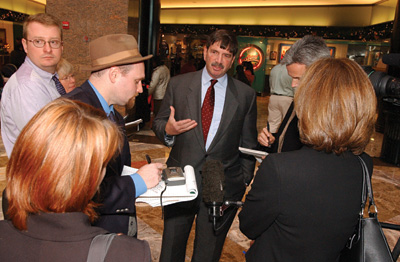|
|
 |
 |
 |
 |
|
FEATUREThe Right Person at The Right TimeBY CHARLES BUTLER '85Lou Tomson '61 Played a Key Role In the Development of Plans for The World Trade Center Site
Lou Tomson ’61 wants to show a visitor something. For the past 30 minutes, he’s been talking about the potential — as well as the politics — of the former World Trade Center site. Now, he wants to put it in perspective. He grabs his cup of coffee. With his 6-foot-3-inch frame, which for a few extra pounds around the middle hasn’t changed much since his heavyweight crew days at Columbia, he rumbles from his office to a conference room in the headquarters of the Lower Manhattan Development Corp. Here, 20 floors up, nothing gets in the way of looking straight down into the pit that’s Ground Zero. Tomson sips his coffee, then starts pointing things out. His voice seems detached; it hardly wavers. “It’s difficult to recognize the enormity of the site. This north-south concrete box, that’s the 1/9 train,” he says, pointing to one end of the pit. He moves his right hand, trying to trace the PATH train, which until 9-11 shuttled commuters from New Jersey into lower Manhattan. “The PATH is being rebuilt. Look at that piece of equipment, an earthmover. It looks like a toy [from here],” he says. He goes on for a few more minutes, pointing out other keys to the 30 million square feet of space. But then, as he is about to finish what seems like just another tour, he pauses. His voice dips slightly. “All gone. Amazing, isn’t it? People say the site has been recovered, but when you look at 2,800 people murdered here … I don’t even like talking about the property destruction, because in comparison, it’s meaningless.”
Still, for all that loss, Tomson was given a job after 9-11: Bring as much life as possible back to the area. In January 2002, Governor George Pataki appointed Tomson executive director of the LMDC. The mandate of the state-city agency is to spearhead reconstruction of the WTC site as well as oversee plans for a memorial to honor those lost in the attack. “Lou Tomson is the right person at the right time for this critically important job,” Pataki said at the time of the appointment. For Tomson, the job presented a headliner’s role after a career packed with behind-the-scene parts in the private and government sectors. He had held a variety of posts in the Pataki administration, including first deputy secretary, where he was responsible for policy developments for the state’s 60-plus public authorities, including the Long Island Power Authority and the MTA (Tomson is credited with the reduced bus and subway fares that came with weekly and monthly MetroCards). A 1964 Law School graduate and the son of a Nassau County, N.Y., judge, Tomson also had been a partner with two law firms. The LMDC, though, presented perhaps Tomson’s biggest challenge: overseeing the process of building the agency’s staff, which numbers more than 40; finding office space and financing; and, most importantly, getting design plans in place so that new structures and a memorial can be built. “I’m sort of an auto mechanic,” Tomson once said of his position. “I’m looking at a new engine, and it’s my job to make it run.” In February, that work culminated with the selection of Berlin-based architect Daniel Libeskind’s 1,776-foot design for the new structure at the site. The selection concluded 13 vigorous months for Tomson. “I think we not only produced a wonderful plan, but a plan that works and is buildable,” Tomson says. But the effort did not come without trials. Not only did Tomson spend much of his time living in a Manhattan hotel and away from his home near Albany, but also he, like others in the process, became a target of criticism for politicians, lower Manhattan residents, the media and 9-11 survivors regarding the pace and the scale of the rebuilding. After an initial set of design plans was roundly derided last July, new prototypes were unveiled in December to a more enthusiastic response. But still there were detractors: Former New York City Mayor Rudy Giuliani chafed because the plans addressed commercial and office space but not a memorial.
Given such circumstances, and the hints that Tomson started dropping late last year, it surprised no one when he resigned from the job shortly after the Libeskind announcement. “This job wore me out. It was the hours, as well as the need to accommodate many hostile opinions,” he said this spring from his home in Voorheesville, N.Y., where he lives with his wife, Ingegerd. To illustrate his point, Tomson tells of how a seemingly off-the-cuff remark made during his tenure came back to haunt him. “I once said that New York City is sort of like of like a lobster. If it loses a claw, it will regenerate a claw. If you left [New York City] alone, it had the capacity to regenerate itself.” But later, at a hearing to discuss the development plans, the mother of a 9-11 victim confronted Tomson, saying, “You said you could regenerate New York. Well, let me see you regenerate my son.” Her comment, Tomson says, “was very passionate, and it was very painful. And the pain of those kinds of things sticks with you.” Someone with only praise for Tomson, though, is Kenneth Jackson, Jacques Barzun professor of history and social sciences, a New York City expert and president of the New-York Historical Society. Jackson got to know Tomson while giving the LMDC staff a tour of memorials commemorating other New York City tragedies including the Triangle Shirtwaist Factory Fire and the Prison Ships Martyrs Monument in Fort Greene Park, Brooklyn. Jackson contends that the enormity of the Ground Zero project, and the countless emotions and opinions it has sparked, makes gaining consensus on its future impossible. He notes, however, that “[Tomson] was even-tempered and tried to make [the process] as fair and objective as possible.” Taking mixed messages and funneling them into a useful, clear direction is a lesson Tomson says he best remembers from his Columbia days. (Others memories are a bit more clouded: “I think I concentrated in art history, but it could have been English.”) Tomson, who transferred to Columbia in his sophomore year after spending one year at Miami of Ohio University, considers his liberal arts education and the Core Curriculum ideal preparation for the eclectic career, which involves multitudes of constituents, that he carved for himself. Tomson knows that his role at the LMDC made him a magnet for opinions. His challenge was to use the diverse voices to move the process along, not stall it. And with preliminary plans in place to rebuild lower Manhattan, Tomson can look back satisfied that he fulfilled a job presented from a day like no other. “I was driving down Route 32 outside of Albany,” Tomson says, remembering September 11, 2001. “It was a beautiful day. Being away from the New York City, I’m looking at the sky — only 140 miles from New York — and saying, ‘How could a plane fly into the World Trade Center on a day like this?’ It seemed so strange.” He takes a breath, then adds, “It’s wonderful to be given the opportunity to serve in a circumstance like that, and try to make things better.” Charles Butler ’85 is an articles editor with SmartMoney magazine in New York.
|
|
|||||||||||||||||||||||||||||||||||||||||||||||||||||||||||||||||


